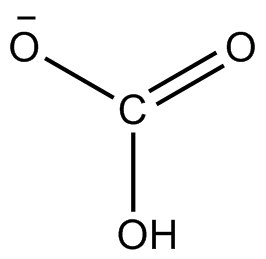Bicarbonate
Editor-In-Chief: C. Michael Gibson, M.S., M.D. [1]
Overview
In inorganic chemistry, a bicarbonate (IUPAC-recommended nomenclature: hydrogencarbonate) is an intermediate form in the deprotonation of carbonic acid.
Chemical properties

The bicarbonate ion (hydrogen carbonate) is an anion with the empirical formula HCO3− and a molecular mass of 61.01 daltons; it consists of one central carbon atom surrounded by three oxygen atoms in a trigonal planar arrangement, with a hydrogen atom attached to one of the oxygens. The bicarbonate ion carries a negative one formal charge and is the conjugate base of carbonic acid, H2CO3; it is the conjugate acid of CO32−, the carbonate ion as shown by these equilibrium reactions.
CO32- +2 H2O ⇋ HCO31- + H2O + OH1- ⇋ H2CO3 +2 OH1-
H2CO3 +2 H2O ⇋ HCO31- + H3O1+ + H2O ⇋ CO32- +2 H3O1+
A bicarbonate salt forms when a positively charged ion attaches to the negatively charged oxygen atoms of the ion, forming an ionic compound. Many bicarbonates are soluble in water at standard temperature and pressure, particularly sodium bicarbonate and magnesium bicarbonate; both of these substances contribute to total dissolved solids, a common parameter for assessing water quality.
Physiological role
Bicarbonate is a crucial component of the pH buffering system of the body (maintaining homeostasis). 86%-90% of CO2 in the body is converted into carbonic acid (H2CO3), which can quickly turn into bicarbonate (HCO3-).
With carbonic acid as the central intermediate species, bicarbonate, in conjunction with water, hydrogen ions, and carbon dioxide forms this buffering system which is maintained at the volatile equilibrium required to provide prompt resistance to drastic pH changes in both the acidic and basic directions. This is especially important for protecting tissues of the central nervous system, where pH changes too far outside of the normal range in either direction could prove disastrous. (See acidosis, or alkalosis.)
Other uses
The most common salt of the bicarbonate ion is sodium bicarbonate, NaHCO3, which is used as baking soda. When exposed to an acid such as acetic acid (vinegar), bicarbonates release carbon dioxide. This is used as a leavening agent in baking.
The flow of bicarbonate ions from rocks weathered by the carbonic acid in rainwater is an important part of the carbon cycle.
Bicarbonate also serves in the digestive system. It raises the internal pH of the stomach, after highly acidic digestive juices have finished in their digestion of food.
Bicarbonate Compounds
- Sodium bicarbonate
- Potassium bicarbonate
- Calcium bicarbonate
- Ammonium bicarbonate
- Carbonic anhydrase
See also
External links
| File:Wiktionary-logo-en-v2.svg | Look up bicarbonate in Wiktionary, the free dictionary. |
- Bicarbonates at the US National Library of Medicine Medical Subject Headings (MeSH)
cs:Hydrogenuhličitan de:Hydrogencarbonate he:ביקרבונט fi:Vetykarbonaatti sv:Vätekarbonatjon